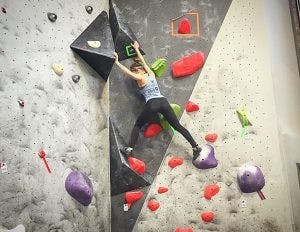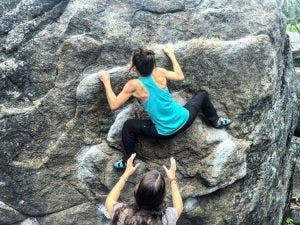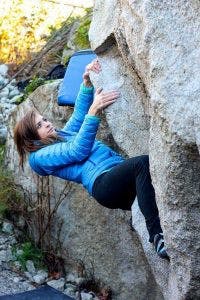
Bouldering is different than just climbing. With bouldering, there is no rope, no one holding you up, it’s just you on a wall 11 feet up in the air, clutching onto the holds with the tips of your fingers and your toes.
Junior Harper Dykes is a relative newcomer to the sport, but it has quickly become her passion.
“I really didn’t want to [climb] at first,” Dykes said. “I was like ‘Hm, that’s dumb. I’m not going to climb a bunch of rocks.’ As soon as I did it, the first day I was like ‘I am probably never going to stop.’”
When bouldering, climbers aren’t strapped in, so falls can be extremely dangerous without proper equipment like crash pads and a good spotter, someone who makes sure you fall on the pad. Climbers risk broken bones, concussions, twisted ankles and ripped open hands while bouldering. The biggest difference between indoor and outdoor climbing is a thing called “no-fall zones,” which is exactly what it sounds like: If you fall, you die.
Dykes said she likes the lack of competition. When she goes into a gym or is working on a project outdoors, she mostly competes against herself and tries to do better than she did the previous time.
“The lack of competition gives way for lots of different body types to achieve the same goal. Some people might be taller and more flexible, while others are much stronger and have a lot more endurance,” Dykes said. “It’s important for people to understand that literally anyone can climb.”
"As soon as I did it, the first day I was like ‘I am probably never going to stop.’”
Harper Dykes
The transition from climbing outdoors to climbing indoors is one Dykes recently made.
“I never understood the love I could have for climbing until I put what I had learned in the gym into play outdoors,” Dykes said. “It sounds really lame, but it is almost like a spiritual experience, when you are on a rock 13 feet in the air and shaking and you are so terrified, but you do it anyway.”

Senior Liv Raster has been bouldering since a young age, even before she knew what the sport was called.
“Growing up where I grew up, there wasn’t really a gym, I just climbed around rocks. When I came here, it was such a big culture,” Raster said. “I never had ropes and gear. They call it scrambling.”
Raster has been seriously climbing for three and a half years, and got into the sport in Bellingham because her friend took her to Vital, the local climbing gym.
“I remember doing this really hard route that nobody at the gym at the time had finished, and I got to the last move and everyone was so supportive at [Vital], a crowd was underneath me like ‘You got this Liv.’ They [didn’t] know me, obviously, but they were super nice and I ended up getting it because I think everyone was supporting me,” Raster said.
Junior Tara Quattrone initially got involved in bouldering her freshman year and has since used it to take on new challenges.
“I like indoor bouldering to train to climb outside, and that’s really why I climb,” Quattrone said. “Climbing up and getting on top of a mountain that way is the most exhilarating feeling and the biggest accomplishment.”
“It has a fear factor to it that makes it really exciting, it’s super addicting,” she said.
In the three years Quattrone has spent climbing, she has competed on Western’s climbing team and in multiple competitions that have taken place at Vital. With all of her experience she was happy to share some advice for people who were looking to get into climbing.
“Be patient with yourself at first because it takes a long time for your tendons, muscles and hands to build up,” Quattrone said. “Just give yourself time.”
Her biggest piece of advice?
“Go outside, don’t just stay inside.”
Climbing indoors and outdoors both come with their own merits, but many consider outdoor climbing, while harder, to be more exciting, and it comes with a very different set of risks. While climbing outdoors, there are variables that climbers can’t control, such as rock type, rock consistency, and weather conditions — all of which can have a huge impact on the conditions and safety of outdoor routes.
Junior Eric Stratton has been climbing for three years, and has nearly given up indoor climbing.

“Climbing outside feels a little bit more gnarly,” Stratton said. “It’s easier to hold yourself to it because there’s not so much give, everything is so much more solid when you hit it.”
Climbing can be found both outdoors and indoors in Bellingham; there are rock walls in the Wade King Student Recreation Center and Vital.
Junior Milo Holston has been climbing for three years, and is a regular at both places. He uses climbing as a means to be both social and active.
“It’s fun to make it into the gym to workout, but sometimes the weight room can be a pretty antisocial space, and the rock wall seems open and social but [is] still workout focused. It’s a cool balance,” Holston said.
The social aspect is something that is often overlooked about climbing, and the community itself has become a home to many.
“The climbing community is pretty great,” Quattrone said. “Whenever you’re climbing anywhere people always cheer you on and that’s really cool to know. When you meet climbers you do feel like you’re more of a family.”
Vital is open 11 a.m. - 9 p.m. every day, and is available to climbers with a membership. Memberships cost $55 a month, or $12 per day.





